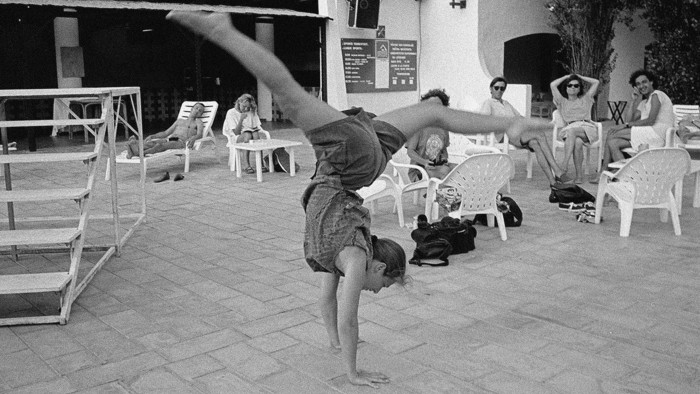Unlock the Editor’s Digest for free
Roula Khalaf, Editor of the FT, selects her favourite stories in this weekly newsletter.
It’s a Friday evening in Paris, and I’m questioning my priorities as I hold a reluctant plank pose on the wooden floor of a dance studio in the 11th arrondissement. Teacher Julien Mauclert is taking a dozen of us through a series of gruelling conditioning exercises to prep for the key stage of his inversion class: the handstand. In fact, he is wearing a T-shirt proclaiming: “For Handstand Lovers Only”.
Hand balancing, as purists call it, is simultaneously spectacular and fully achievable – if you are willing to put in the hours. Fans will go to any length to achieve the perfect form. Classes, workshops and even retreats are now being dedicated to the pursuit of “standing” for as long as possible, perhaps bringing in stylistic twists – a tuck or straddle – or extra challenges, such as pressing up with both legs at once, or progressing to the complex one-armed handstand.

Despite being a seasoned yogi, I was reluctant to embrace the handstand – it seemed like a futile pursuit. But as friends divulged their obsession, I decided to try it for myself. For Mauclert, a former circus artist, balancing is also “a way of reconnecting with the earth. It’s very grounding, perhaps even more so than a traditional yoga practice”. The stylish French magazine editor Julia Tissier, a regular student of Mauclert’s, says working on her balances is the only time she feels “100 per cent focused”. The exhilarated faces and big smiles around the room point to another, equally addictive element: handstands are fun.


“There’s a huge adrenaline rush when you go upside down,” explains Genny Wilkinson, co-owner of Spitalfields’ Mission E1 studio, which was the first in London to offer handstand practices when it opened in March 2023. “The classes were waitlisted from day one,” she adds. Nicki Ratcliffe, one of Mission’s specialist teachers, jokes that students gave her a whistle to maintain order in her highly popular classes, which attract practitioners into their 60s as well as Royal Ballet dancers and the occasional Spice Girl. Literary agent Rachel Mills, a regular, loves the futility of it: “My business isn’t going to fail if I bail out of a tuck. But when you do achieve something, it is pure joy!” But there is also a clear physical journey: “It is about technique,” says Ratcliffe, who includes ankle weights and yoga transitions in her approach.

Where to practise
Mission E1 in London offers 14 classes a week for all levels, as well as six-week courses and regular weekend workshops, including sessions with Yuval Ayalon; the next will be on 22 and 23 March.
Mission teachers Nicki Ratcliffe and Sammy Dinneen also offer retreats and individual classes.
Yuval Ayalon gives international workshops.
Julien Mauclert offers weekly classes in four Parisian studios, plus workshops and weekend retreats.
Who to follow
@london_school_of_hand_balance_
What to wear
Mouche Cousue “For Handstand Lovers Only” T-shirt, €45
After an hour’s solid drill work, my own shoulders are aching and my brain is equally discombobulated trying to integrate Mauclert’s anatomical prompts while upside down: wrists, shoulders and hips aligned, navel in, pelvis tilting backwards. “Your proprioception goes haywire at first,” explains the teacher, who is disconcertingly à l’aise whilst in any form of handstand. Physical boundaries such as my apparently “closed shoulders” can be limiting, but mental ones are also problematic.
Yuval Ayalon, the international star of hand balancing with 126,000 followers on Instagram, deals with the phobia of falling from the get-go in his workshops: “You need to respect fear, and work on an exit strategy to know how to bail out.” A former international gymnast and acrobat, Yuval was one of the first to share his daily balancing practice online, and has been teaching full-time since 2013. He compares the day-to-day work on strength and flexibility to the honing of a musical talent: “It’s a continuous investment.”

For Marialuisa Gorla, Head of corporate finance at liberty global and a student of Yuval’s since 2019, the journey towards one-armed balance involves two hours of daily toil in a busy schedule: “I feel it’s the only thing I have control over!”, she jokes. For the less advanced practitioner, commitment is still key. Sammy Dinneen, another Mission E1 teacher, suggests working “little and often”, like a child learning to walk, and advises focussing on building both shoulder strength and flexibility – “unlike what people think, it’s not all about the core”.
Every teacher I speak to emphasises the importance of starting out with a real-life class, both for the community aspect and to achieve awareness of the body in space, with technical tips and hands-on correction. Then, it’s all about regularity and dedication, whether in a studio, online or at home. After 90 minutes of hard graft and one thrilling almost-handstand in the centre of the room, I’m hooked. Now if I can just work on those pesky shoulders…
This article was originally published by a www.ft.com . Read the Original article here. .

